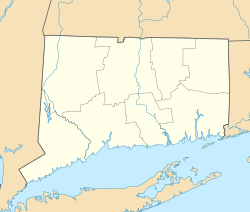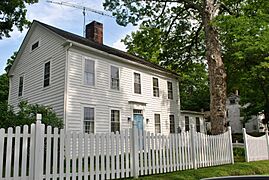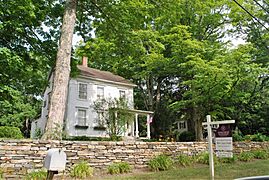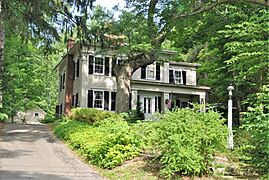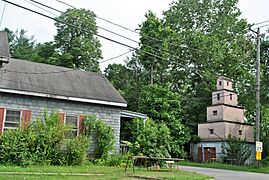Gaylordsville, Connecticut facts for kids
Quick facts for kids
Gaylordsville, Connecticut
|
|
|---|---|
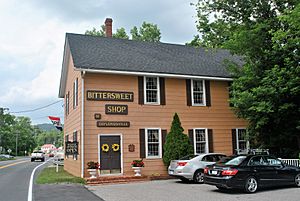
Gaylordsville, Connecticut
|
|
| Country | |
| State | Connecticut |
| County | Litchfield |
| Town | New Milford |
| Area | |
| • Total | 4.27 km2 (1.65 sq mi) |
| • Land | 4.12 km2 (1.59 sq mi) |
| • Water | 0.16 km2 (0.06 sq mi) |
| Elevation | 90 m (280 ft) |
| Population
(2020)
|
|
| • Total | 660 |
| Time zone | UTC-5 (Eastern (EST)) |
| • Summer (DST) | UTC-4 (EDT) |
| ZIP Code |
06755
|
| Area code(s) | 860/959 |
| FIPS code | 09-30470 |
| GNIS feature ID | 2805982 |
Gaylordsville is a small village located in the northwest part of New Milford, in Litchfield County, Connecticut. It's known as a "census-designated place" (CDP), which means it's a specific area recognized by the U.S. Census Bureau for collecting population data. In 2020, about 660 people lived here.
Contents
History of Gaylordsville
The story of Gaylordsville begins with the Gaylord family, who were early settlers in New England.
The Gaylord Family Arrives
In 1630, William Gaylord came to America on a ship called the "Mary and John". He arrived in Dorchester, Massachusetts, with his wife and five sons. William was an important member of his church and helped manage the colony. He even served on the first jury! Later, he moved to East Windsor, Connecticut.
Moving to New Milford
William's great-grandson, Ensign William Gaylord, moved to Woodbury in 1706. He married Joanna, whose sister was an ancestor of President Grant. In 1712, William and Joanna Gaylord moved to New Milford, which was a very new settlement at the time. Their home was on Main and Elm Streets. William worked as a surveyor, mapping out land. He often traveled to survey new areas.
Settling the Valley
During his surveying trips, William Gaylord was impressed by the flat land several miles north of New Milford. This area was near the Housatonic River. He started buying pieces of this land and soon owned a large part of the valley. To be fair to the Native Americans living there, he also bought the land from them. Legend says he gave them a horse, a mule, and a two-wheeled cart.
In 1722, a road was marked out from New Milford to a brook called Whemiseck. William Gaylord likely helped plan this road. He probably made sure it went over Cedar Hill to protect his valuable flat fields.
Building a Home
In 1725, Mr. Gaylord traveled this new trail and built a log cabin west of the Housatonic River. He lived in this cabin for three years while he cleared land and cut trees. In 1728, he built his main house. The next year, his oldest son, Aaron, built his own house nearby.
The Gaylord family became good friends with their Native American neighbors. They taught them better farming methods and traded furs. William Gaylord passed away on October 25, 1743, at age 73. He and Mrs. Gaylord were the first people buried in a cemetery near their home.
Geography of Gaylordsville
Gaylordsville is located in the northwest corner of New Milford. It's in a valley that Native Americans called the Wheniuck or Red Plumb Plain.
Natural Boundaries
To the east, the village is bordered by Quanuctnic, also known as Long Mountain. The exact southern border is not very clear, but it's usually thought to be south of the Tory Cave on the Housatonic River. The town line of Sherman forms the western border. However, some homes in Sherman are still considered part of the Gaylordsville community.
Rivers and Brooks
The Housatonic River flows right through the middle of Gaylordsville. Several smaller brooks join the Housatonic here. These include the Wimisink, Womunshenuck, Morrissey (also called Naromiyocknowhusunkatankshunk), and Squash Hollow brooks. The southern part of the valley is split into two smaller valleys by Straits Mountain, also known as Pauguiack. The northern end of this mountain, called "the Pinnacle," offers a view of the village. Gaylordsville is generally about four miles long and one mile wide.
Historical Sites to Visit
Gaylordsville has some cool historical spots that show its past.
- Brown's Forge: This was a blacksmith shop built in 1870. Blacksmiths made and repaired metal tools and items.
- The Little Red Schoolhouse: This school operated from 1740 to 1967. It was the very last one-room schoolhouse still running in Connecticut! It was a primary school for New Milford for 227 years.
- Merwinsville Hotel: This historic hotel was built in 1843.
Notable People from Gaylordsville
Many interesting people have lived in or had connections to Gaylordsville.
- Rex Brasher: An American watercolor painter and expert on birds (an ornithologist). He passed away here in 1960.
- Katharine Anthony: A writer who wrote biographies (life stories) of famous people.
- Elisabeth Irwin: She founded the Little Red School House in New York City, a well-known progressive school.
- F. Luis Mora: An American painter born in Uruguay. He built a house on Cedar Hill Road in 1926 and lived there.
- Isaac Stern: A world-famous violinist.
- Nan Watson: A talented artist.
Gallery


